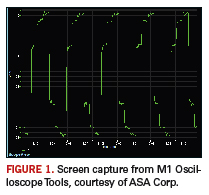
Understanding how to reproduce a signal integrity problem is the first
step in finding the root cause and resolving the anomaly.
In graduate school, I used to hang out with friends who were amateur
magicians. We would go to a magic performance and then sit around over
beers trying to figure out how the magician did a particular trick. How
did he levitate the glowing ball and get it to move around seemingly at
his command?
I learned a valuable methodology from my magician friends. The most
successful approach we used to deduce how the magician did a trick was
to always start with the question, "If I wanted to reproduce this
trick, how would I do it?"
Once we had a plan, we would then ask, if he did it this way, we should
see him walk out on stage toward the front of the stage to avoid the
hidden string, or his right hand should never cross his left hand. We
would identify clues to look for to indicate the method he used.
Of course, the reason this was a successful approach for us was that
between the five of us, we had a rich experience base of how tricks can
be performed. Being clever amateur magicians, and lubricated with a few
beers, we never seemed to be at a loss for possible, alternative
methods.
Sometimes, the clever magician would change the trick and the method
between performances, maybe to keep us amateurs guessing, or make it
more interesting for him. Nine times out of 10, in the next
performance, we were able to pick up the clues and have confidence we
figured out the trick. Rarely, did the trick completely escape us.
These were the brilliant magicians we respected as masters. If only we
could have had them on our analysis team!
Surprisingly, this was one of the most valuable lessons I learned in
graduate school. It applies not just to determining the method of a
magic trick, but also to determining the root cause of a signal
integrity problem. Of course, the right way of designing a system is to
design signal integrity problems out of your product right from the
beginning.
But sometimes, they creep in. During the bring-up phase, you perform
measurements of signal waveforms and find anomalies.
Figure 1 is an
example of a measured scope trace of a waveform in a digital system.

It's not supposed to have those stair step glitches in it. Not getting
the signal up to the minimum input high for a 1 or below the maximum
input low for a 0 within the set up and hold time will mean a false
reading, or the possibility of a metastable response in the receiver.
You need to fix this problem. Once the problem has been identified, the
next step in fixing it is to determine the root cause. Usually, once
the root cause is found, the solution is obvious.
What I learned from my magician friends is that the most effective
process to find the root cause of a problem is to ask yourself the
question, "If I wanted to reproduce this trick, how would I do it?"
How could you re-create the waveform in this example? It is often
difficult to "synthesize"Â an approach from scratch. This is where
experience is incredibly valuable. Cheating is allowed; you are allowed
to ask others, to look at reference books and papers; having a few
experts on your team helps. After all, what's an expert but "someone
who's made all the mistakes possible?"
Â
A recently announced tool from ASA Corp (amherst-systems.com) might
also help. HAL, short for Hidden Anomaly Locator, uses software agents,
each tasked to be on the look out for a specific type of problem. HAL
will monitor scope waveforms, on the look out for anomalies. Once
found, it will offer suggestions for possible root causes. It's like
having a bunch of experts on your team.
In the example above, what might have caused the stair step shelves?
One possible explanation is impedance mismatches in a source series
terminated line. If the source series resistor was too high, it might
cause this effect.
One clue to look for is the duration of the shelf. It should be the
round-trip delay time of the transmission line. Another clue might be
the value of the series resistor. A typical CMOS driver has an output
impedance of 10 Ohms, which would require a resistor of about 40 Ohms.
To reproduce this stair step waveform, a resistor of about 80 Ohms
would be needed. Check the resistance of the resistor on the board.
Problems can turn from stumbling blocks into stepping stones only if
you learn the correct lesson from them and move farther up the learning
curve. Take advantage of all the help you can.
PCD&F
Dr. Eric Bogatin is president of Bogatin Enterprises. This and other
topics are covered in the public classes Eric teaches. Check his web
site for the schedule: BeTheSignal.com. Send questions to
This email address is being protected from spambots. You need JavaScript enabled to view it..















